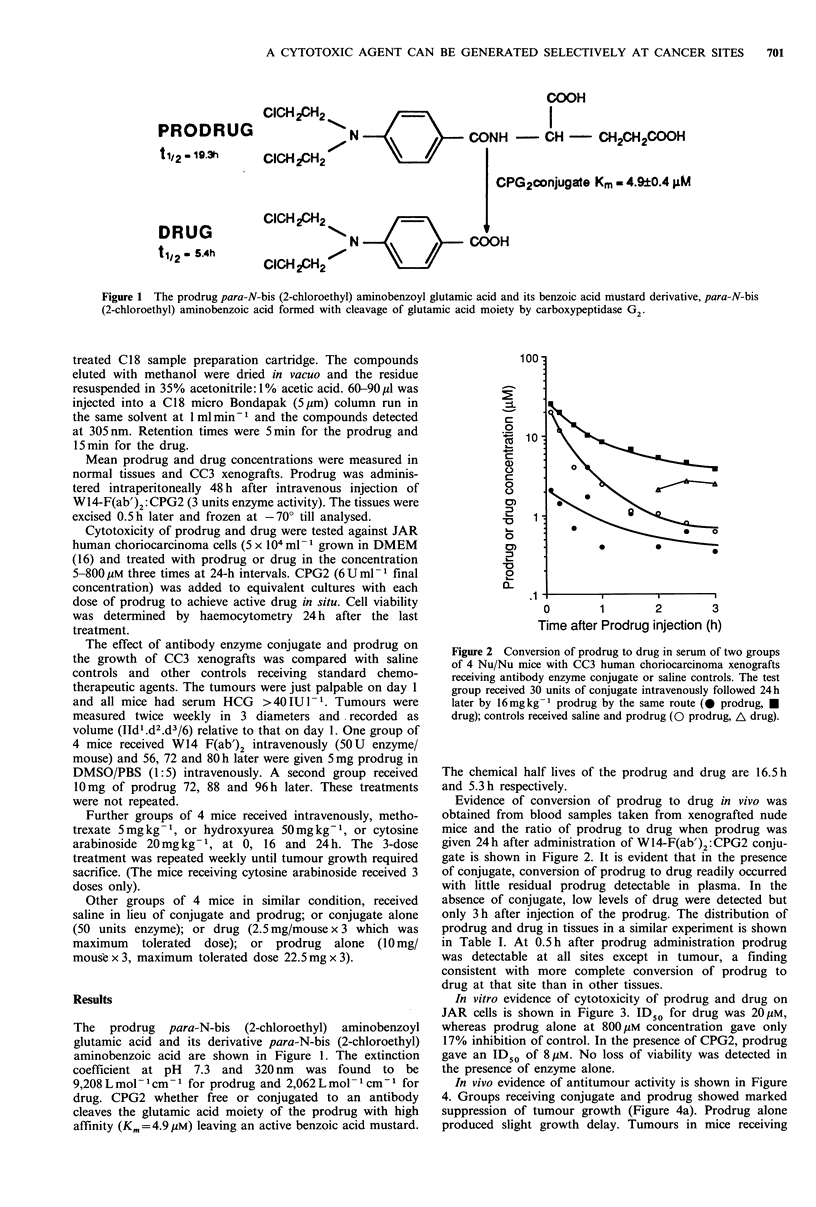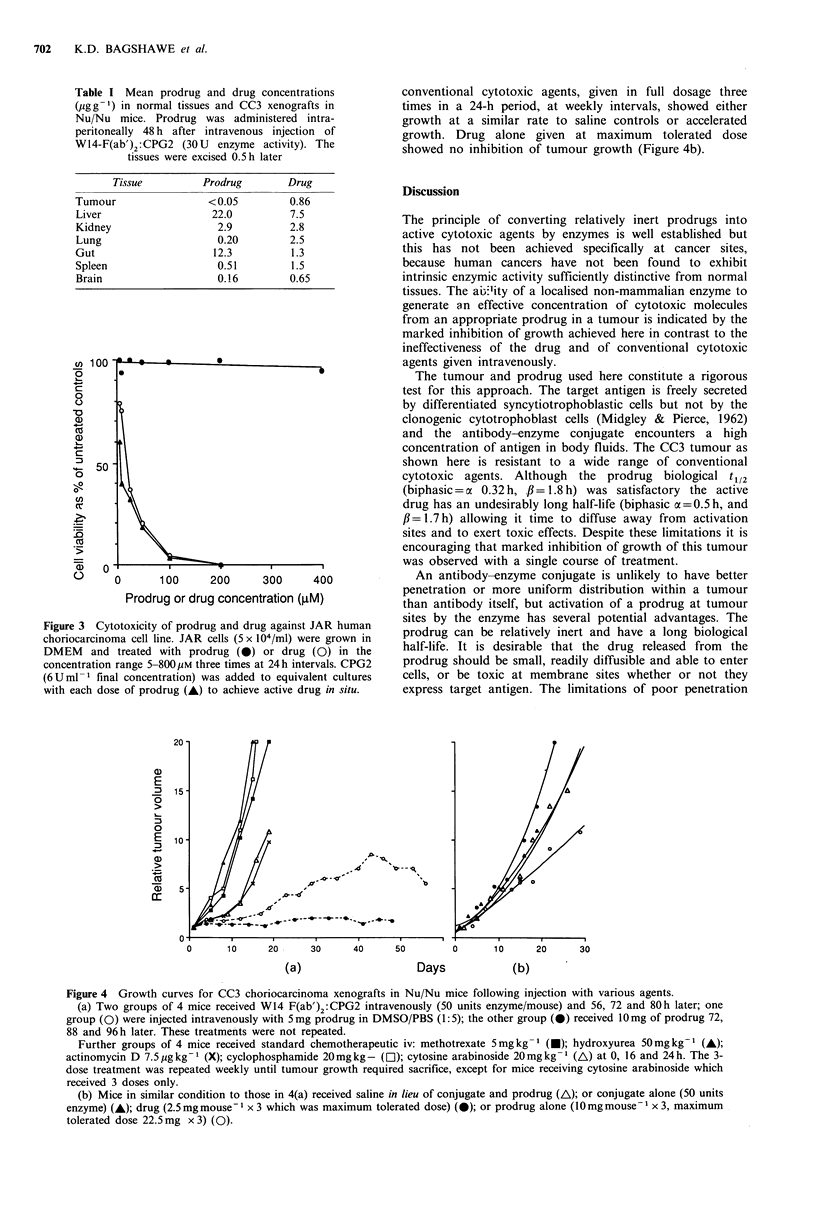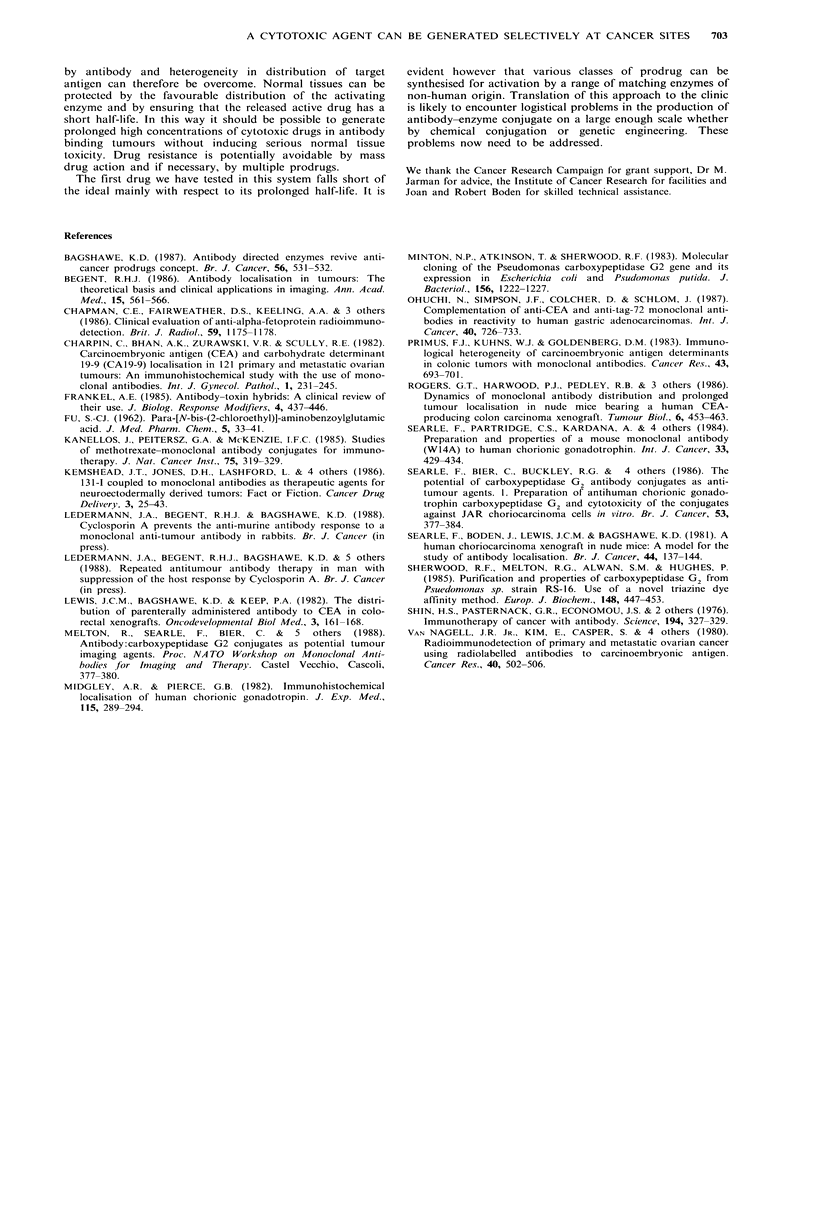Abstract
Attempts to improve the selectivity of anti-cancer agents by conjugating them to antibodies directed at tumour associated antigens have demonstrated tumour localisation but only limited therapeutic success. We report here the advantage of a 2-stage approach in which the first component combines the selective delivery of antibody with a capability to generate a cytotoxic agent from a second subsequently administered component. A bacterial enzyme, carboxypeptidase G2 (CPG2) was conjugated with F(ab')2 fragment of a monoclonal antibody directed at beta subunit of human chorionic gonadotrophin (beta-hCG) and injected into nude mice bearing hCG producing CC3 xenografts of human choriocarcinoma. Time was allowed for the conjugate to localise at tumour sites and clear from blood before injecting para-N-bis (2-chloroethyl) aminobenzoylglutamic acid. Cleavage of the glutamic acid moiety from this molecule by CPG2 released a benzoic acid mustard. Growth of the tumour which is resistant to conventional chemotherapy was markedly depressed by a single course of treatment. This demonstrates for the first time the potential of an antibody directed enzyme to activate an alkylating agent and to eradicate an established human cancer xenograft.
Full text
PDF



Selected References
These references are in PubMed. This may not be the complete list of references from this article.
- Bagshawe K. D. Antibody directed enzymes revive anti-cancer prodrugs concept. Br J Cancer. 1987 Nov;56(5):531–532. doi: 10.1038/bjc.1987.237. [DOI] [PMC free article] [PubMed] [Google Scholar]
- Chapman C. E., Fairweather D. S., Keeling A. A., Chandler S. T., Dykes P. W., Bradwell A. R. Clinical evaluation of anti-alpha-fetoprotein radioimmunodetection. Br J Radiol. 1986 Dec;59(708):1175–1178. doi: 10.1259/0007-1285-59-708-1175. [DOI] [PubMed] [Google Scholar]
- Charpin C., Bhan A. K., Zurawski V. R., Jr, Scully R. E. Carcinoembryonic antigen (CEA) and carbohydrate determinant 19-9 (CA 19-9) localization in 121 primary and metastatic ovarian tumors: an immunohistochemical study with the use of monoclonal antibodies. Int J Gynecol Pathol. 1982;1(3):231–245. doi: 10.1097/00004347-198203000-00001. [DOI] [PubMed] [Google Scholar]
- FU S. C. PARA-(N-BIS-(2-CHLOROETHYL))-AMINOBENZOYLGLUTAMIC ACID. J Med Pharm Chem. 1962 Jan;5:33–41. doi: 10.1021/jm01236a004. [DOI] [PubMed] [Google Scholar]
- Frankel A. E. Antibody-toxin hybrids: a clinical review of their use. J Biol Response Mod. 1985 Oct;4(5):437–446. [PubMed] [Google Scholar]
- Kanellos J., Pietersz G. A., McKenzie I. F. Studies of methotrexate-monoclonal antibody conjugates for immunotherapy. J Natl Cancer Inst. 1985 Aug;75(2):319–332. [PubMed] [Google Scholar]
- Kemshead J. T., Jones D. H., Lashford L., Prichard J., Gordon I., Breatnach F., Coakham H. B. 131-I coupled to monoclonal antibodies as therapeutic agents for neuroectodermally derived tumors: fact or fiction? Cancer Drug Deliv. 1986 Winter;3(1):25–43. doi: 10.1089/cdd.1986.3.25. [DOI] [PubMed] [Google Scholar]
- Lewis J. C., Bagshawe K. D., Keep P. A. The distribution of parenterally administered antibody to CEA in colorectal xenografts. Preliminary findings. Oncodev Biol Med. 1982;3(2-3):161–168. [PubMed] [Google Scholar]
- MIDGLEY A. R., Jr, PIERCE G. B., Jr Immunohistochemical localization of human chorionic gonadotropin. J Exp Med. 1962 Feb 1;115:289–294. doi: 10.1084/jem.115.2.289. [DOI] [PMC free article] [PubMed] [Google Scholar]
- Minton N. P., Atkinson T., Sherwood R. F. Molecular cloning of the Pseudomonas carboxypeptidase G2 gene and its expression in Escherichia coli and Pseudomonas putida. J Bacteriol. 1983 Dec;156(3):1222–1227. doi: 10.1128/jb.156.3.1222-1227.1983. [DOI] [PMC free article] [PubMed] [Google Scholar]
- Ohuchi N., Simpson J. F., Colcher D., Schlom J. Complementation of anti-CEA and anti-TAG-72 monoclonal antibodies in reactivity to human gastric adenocarcinomas. Int J Cancer. 1987 Dec 15;40(6):726–733. doi: 10.1002/ijc.2910400603. [DOI] [PubMed] [Google Scholar]
- Primus F. J., Kuhns W. J., Goldenberg D. M. Immunological heterogeneity of carcinoembryonic antigen: immunohistochemical detection of carcinoembryonic antigen determinants in colonic tumors with monoclonal antibodies. Cancer Res. 1983 Feb;43(2):693–701. [PubMed] [Google Scholar]
- Rogers G. T., Harwood P. J., Pedley R. B., Boden J., Rawlins G., Bagshawe K. D. Dynamics of monoclonal antibody distribution and prolonged tumour localisation in nude mice bearing a human CEA-producing colon carcinoma xenograft. Tumour Biol. 1986;6(5):453–463. [PubMed] [Google Scholar]
- Searle F., Bier C., Buckley R. G., Newman S., Pedley R. B., Bagshawe K. D., Melton R. G., Alwan S. M., Sherwood R. F. The potential of carboxypeptidase G2-antibody conjugates as anti-tumour agents. I. Preparation of antihuman chorionic gonadotrophin-carboxypeptidase G2 and cytotoxicity of the conjugate against JAR choriocarcinoma cells in vitro. Br J Cancer. 1986 Mar;53(3):377–384. doi: 10.1038/bjc.1986.62. [DOI] [PMC free article] [PubMed] [Google Scholar]
- Searle F., Boden J., Lewis J. C., Bagshawe K. D. A human choriocarcinoma xenograft in nude mice; a model for the study of antibody localization. Br J Cancer. 1981 Aug;44(2):137–144. doi: 10.1038/bjc.1981.163. [DOI] [PMC free article] [PubMed] [Google Scholar]
- Searle F., Partridge C. S., Kardana A., Green A. J., Buckley R. G., Begent R. H., Rawlins G. A. Preparation and properties of mouse monoclonal antibody (W14A) to human chorionic gonadotropin. Int J Cancer. 1984 Apr 15;33(4):429–434. doi: 10.1002/ijc.2910330402. [DOI] [PubMed] [Google Scholar]
- Sherwood R. F., Melton R. G., Alwan S. M., Hughes P. Purification and properties of carboxypeptidase G2 from Pseudomonas sp. strain RS-16. Use of a novel triazine dye affinity method. Eur J Biochem. 1985 May 2;148(3):447–453. doi: 10.1111/j.1432-1033.1985.tb08860.x. [DOI] [PubMed] [Google Scholar]
- Shin H. S., Pasternack G. R., Economou J. S., Johnson R. J., Hayden M. L. Immunotherapy of cancer with antibody. Science. 1976 Oct 15;194(4262):327–329. doi: 10.1126/science.989623. [DOI] [PubMed] [Google Scholar]
- van Nagell J. R., Jr, Kim E., Casper S., Primus F. J., Bennett S., DeLand F. H., Goldenberg D. M. Radioimmunodetection of primary and metastatic ovarian cancer using radiolabeled antibodies to carcinoembryonic antigen. Cancer Res. 1980 Mar;40(3):502–506. [PubMed] [Google Scholar]


